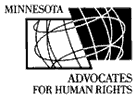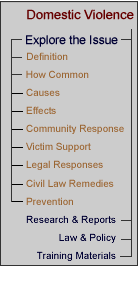|
|
|
DOMESTIC VIOLENCE AND CHILDREN
Children in homes where domestic violence occurs may be witnesses to abuse, may themselves be abused, may suffer harm “incidental” to the domestic abuse, and may be used by the batterer to manipulate or gain control over the victim. The Women’s Rural Advocacy Program offers a good overview of the ways in which children can be affected by domestic violence. Effects on Children First, children are often witnesses to domestic violence. As reported in the Toolkit to End Violence Against Women, created by the National Advisory Council on Violence Against Women and the United States Department of Justice’s Violence Against Women Office, available in PDF and text formats, slightly more than one-half of female victims of domestic violence in the United States live in homes with children under twelve. As witnesses, children can be harmed psychologically and emotionally. Studies indicate that child witnesses, on average, are more aggressive and fearful and more often suffer from anxiety, depression and other trauma-related symptoms. Children growing up in violent homes often take responsibility for the abuse and may feel guilty for not being able to stop it. They live with constant anxiety that another beating will occur, or that they will be abandoned. They may feel guilty for loving the abuser. Children may be at a higher risk of alcohol or drug abuse, experience cognitive problems or stress-related ailments (headaches, rashes), and have difficulties in school. Although the effects of witnessing domestic violence appear to diminish with time, they can continue through adulthood. As adults, child witnesses may continue to suffer from depression and trauma-related symptoms. In addition, while current theories view violence as a means of power and control and not entirely as learned behavior, studies show that boys who witness domestic violence are more likely to batter as adults. In Problems Associated with Children’s Witnessing of Domestic Violence (1999), Jeff Edleson, an expert on children and domestic violence and batterers treatment programs, provides a more in-depth discussion of some of the ways in which children’s health can be affected by witnessing domestic violence. Edleson reviews studies that report behavioral, emotional, cognitive and long-term problems that are statistically associated with a child’s witnessing of domestic violence. Second, research has also shown that there is a strong correlation between child abuse and domestic abuse. As reported in the Toolkit’s chapter on children and domestic violence, available in PDF and text formats, recent national studies have shown that 50% of men who frequently assault their wives also frequently assault their children. The Women’s Rural Advocacy Programs describes the following facts concerning child and spouse abuse in the United States:
A 1998 literature review reported that between 45% and 70% of children who are exposed to domestic violence are also victims of abuse, and that 40% of child victims of abuse are also exposed to domestic violence. From Lynn S. Levey, Martha Wade Steketee & Susan L. Keilitz, Lessons Learned in Implementing an Integrated Domestic Violence Court: The District of Columbia Experience 14 (2000). Third, children may be “inadvertently” hurt through domestic violence. They may be hit by items thrown by the batterer, and older children, in particular, may be hurt trying to protect their mother. Fourth, children are used by batterers to manipulate their victims. A batterer may threaten to take custody of or kidnap the children if the victim reports the abuse; he may also threaten to harm or kill the children. He may also tell her that she will lose custody if she seeks a divorce because she “allowed” the abuse to happen. He may even harm the children in order to control the mother. During and after separation, batterers continue to use these tactics. Visitation and joint custody provide the batterer with opportunities to abuse, threaten and intimidate their former partners. From Kendall Segel-Evans, Wife Abuse and Child Custody and Visitation by the Abuser (1989). The Winter 1999 issue of The Future of Children is dedicated entirely to articles on child exposure to domestic violence. The topics covered in the issue include strategies for addressing the harm to children from domestic violence, effects of domestic violence on children, children and the legal system, and overviews of intervention and service programs throughout the United States. Community Responses The connections between child and spouse abuse indicate a strong need for coordination between child abuse and domestic abuse agencies and advocates. Some communities are working to develop relationships between child abuse and domestic abuse agencies. In particular, because of the correlation between domestic violence and child abuse, it is critical that agencies that work with abused children are trained to recognize signs of domestic violence and to respond appropriately. Susan Schechter, Expanding Solutions for Domestic Violence and Poverty: What Battered Women with Abused Children Need from Their Advocates, discusses some of the specific needs of battered women who have abused children. When a batterer is also abusing a child, the best way to protect the child often is to ensure the safety of the mother. Further, because of the correlation between spouse and child abuse, it is important that the laws governing child abuse and child custody do not have unintended effects on battered women. In the United States, for example, child abuse laws that determined custody according to the “best interests of the child” often held that a women was an unfit parent because she did not protect her child from abuse—even though she was also abused and may not have felt is was safe for her and her child to leave. Another problem arose with laws that required certain people, such as teachers or social workers, to report signs of child abuse. Mandatory reporting without consideration of domestic violence issue may force the woman into a lose-lose situation; when confronted with the signs of abuse, she either reveals the abuser’s responsibility and runs the risk of retaliation, or refuses to do so and potentially loses custody of her children. The Minnesota Department of Human Services offers useful guidelines for responding to situations in which spouse and child abuse are present. Some potential strategies to coordinate the response of child abuse and domestic violence agencies and advocates include joint training, the implementation of protocols that require each agency or group to consult with its counterpart, where appropriate, co-location of staff working on these issues, and establishment of collaborative projects. These and other coordinated efforts are described in In Harm’s Way: Domestic Violence and Child Maltreatment. The Greenbook Initiative is a project designed to help child welfare and domestic violence agencies and family courts work together more effectively to aid families experiencing violence. The Greenbook sets forth recommended principles—designed to further the safety, well-being and stability of victims of family violence and hold batterers accountable—that can be used to guide communities in structuring their responses to these situations. The Greenbook also sets forth specific recommendations for implementing these goals. Effective Intervention in Domestic Violence & Child Maltreatment Cases: Guidelines for Policy and Practice, developed by the National Council of Juvenile and Family Court Judges, also offers guiding principles that can be used to improve responses to dual violence cases. The Toolkit offers recommendations and strategies for designing intervention programs for children affected by domestic violence. Detailed discussion of these intervention strategies, as well as further information about the effects of domestic violence on children, is available in both PDF and text formats. Recent child trauma research programs in the United States have adopted a “dual victim treatment” approach. This approach is based on the premises that mother and child witnesses are dual victims of domestic abuse, and that strengthening the mother-child bond in dual victim cases helps minimize the harm experienced by children. Reports from programs that work to develop the relationship between the two victims through counseling have been dramatic. Not only did the children’s mental and emotional health improve significantly, but only one in forty-five women returned to her abuser. From Joan Zorza, Health Watch, Violence Against Women 22-6 (Joan Zorza ed., 2002). Additional resources on children and domestic violence include Making the Link: Promoting the Safety of Battered Women and Children Exposed to Domestic Violence and Battered Women and Their Children. Janet Carter, Domestic Violence, Child Abuse, and Youth Violence: Strategies for Prevention and Early Intervention, provides an in-depth discussion of the relationship between children’s welfare and domestic violence. |

